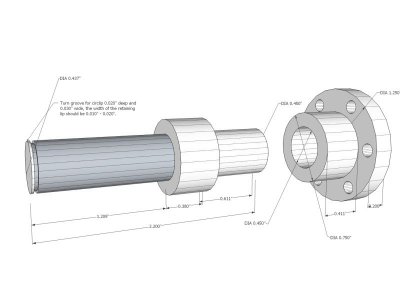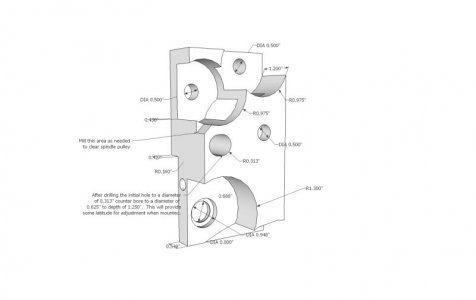Hello Chris, I have had a number of emails and other requests for a better explanation of how this clutch actually works. Let me try with this post.
The article published in the last issue of Home Shop Machinist outlined in some detail the construction methods for build the threading clutch. One area it did not cover is how the clutch functionally does what it does – drive the lead screw in either the forward, reverse or neutral direction. It is the intent of this post to explain how these gears along with the dog clutch perform these tasks.
The clutch assembly consists of five gears and the dog clutch. The gears allow you to select the direction that the lead screw rotates thus providing a forward and reverse motion. A dog clutch is binary positioned clutch, it is either engaged or not engaged there is no in between.
This threading clutch is essentially a series of idler gears that form two parallel gear trains. One train drives the lead screw forward and the other drives the lead screw in reverse. Idler gears only change the direction of rotation and do not change the gear ratios of the gear train. The idler gear may be of any size relative to the gear that is driving the idler or the gear that idler drives, the ratio stays the same. The dog clutch is inserted into the gear train between the spindle gear and the fiber gear that the spindle gear drives. This version of the clutch was designed for the Grizzly G0602 but is easily adapted to many other lathe designs. I will use the G0602 in this explanation.
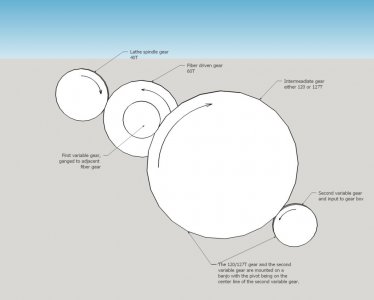
Diagram # 1 – the original gear layout of the G0602 showing the direction of rotation while running in the forward direction. The clutch assembly will be inserted between the spindle gear and driven fiber gear necessitating the relocation of the fiber gear.
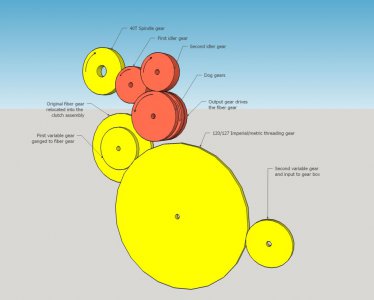
Diagram #2 – This is the gear train layout with the dog clutch gears inserted between the spindle gear and the fiber gear. The original G0602 gears are in yellow and clutch gears are red.
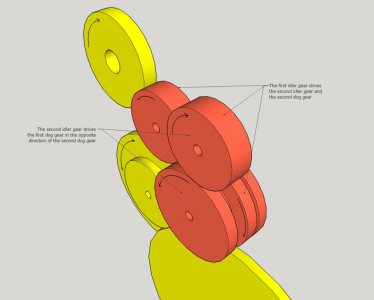
Diagram #3 – The second idler gear drives the first dog gear in the opposite direction when compared to the second dog gear.
Diagram 3 shows how the two dog gears are driven in opposite directions. Inserting an idler gear into a gear train will reverse the direction of the gear train that is connected to that idler gear. Thus we have two gear trains in this clutch the first is driven by the first idler gear which in turn drives the second dog gear. The second gear train starts with the second idler gear which is driven from the first idler gear and then drives the first dog gear but in the opposite direction.
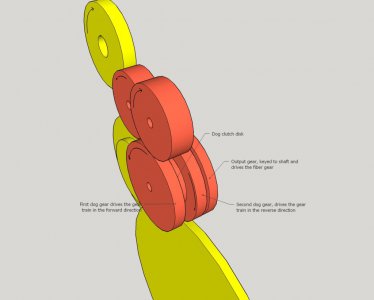
Diagram #4 - shows the two dog gears rotating in opposite directions and straddling the dog clutch disk. The disk is keyed to the output shaft and when the disk is moved to the left or right it engages the a pin in the dog gear which in turn then rotates the output shaft in the desired direction.
The axle that runs through the gear assembly that contains the two dog gears and the output gear consists of two shafts co-axially located. The inner shaft support the assembly and the outer shaft is keyed to the output gear and can be driven by either dog gear or left in neutral. A shifting fork assembly moves the dog disk from one side to the other and is held with a detent.
Hopefully this adds some clarity to how the dog functions. The magazine article in HSM was focused on construction rather than operation. If you have any questions please post them and I will respond to them.
Jim






